Solar Panels and Snow: Comparing the effectiveness of solar panels angled up or down
Grade 6
Presentation
No video provided
Hypothesis
My hypothesis was that the face-up panel would generate a bit more than the face-down panel.
Research
Background Information
- Solar panels use the power of the sun to make an electric current, which conducts into a battery.
- You can put solar panels almost anywhere. This includes on buildings, on the ground and even underwater!
- Snow can reflect light. This is called the albedo effect. Solar panels can absorb this light.
- Solar panels convert 22.8% of the sun’s energy (on average) for industry grade panels.
- When the sun shines on a solar panel, the energy from the sun is absorbed by the photovoltaic (PV) cells inside the panel.
- The energy from the sun makes these electrical charges respond to an electrical field in the cell, making an electric current.
- A PV cell (solar cell) is a non-mechanical thing that turns sunlight right into electricity.
- Some PV cells can turn man-made light into electricity!
- The first successful solar cell was developed in 1950 by Bell Telephone researchers.
Additional Information
Photovoltaic system: https://energyeducation.ca/encyclopedia/Photovoltaic_system (Dr. Jason Donev, University of Calgary) (Accessed February 26, 2024)
Photovoltaic system:
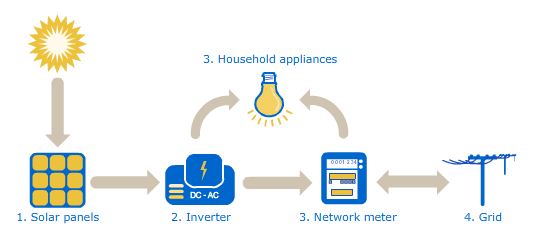
● The components of a photovoltaic system are:
○ Solar panel: solar cells with semiconductor properties which capture light and convert their energy into electricity though a process called the photovoltaic effect.
○ Inverter: an electrical device which accepts electrical current in the form of direct current and converts it into alternating current. Most inverters have conversion efficiencies of 90% or higher and contain important safety features.
○ Racking: the mounting apparatus which fixes the solar array to the ground or rooftop. These should be designed to withstand extreme weather events such as hurricane or tornado level wind speeds and high accumulations of snow.
○ Other components: typical solar systems include combiners, disconnects, breakers, meters and wiring. A solar combiner combines two or more electrical cables into one larger one. Disconnects are electrical gates or switches which allow for manual disconnection of an electrical wire. Circuit breakers protect electrical systems from over current or surges. An electric meter measures the amount of energy that passes through it and is commonly used by electric utility companies to measure and charge customers. For solar photovoltaic systems a special bi-directional electric meter is used to measure both the incoming and and outcoming energy. The wiring transports the electrical energy from and between each component.
Successful projects: https://www.csisolar.com/successful-projects/ (Canadian Solar) (Accessed February 26, 2024)
● Projects from around the world
● There are examples of bifacial projects from China

● This is the TOPBiHiKu7 N-type TOPCon Bifacial Module
How Do Solar Panels Work?: https://science.howstuffworks.com/environmental/energy/solar-cell.htm (Scott Aldous & Talon Homer, HowStuffWorks.com) (Updated: Aug 30, 2023, Accessed February 26, 2024)
● Solar panels that you see on power stations and satellites are also called photovoltaic panels
● “Photo” as in light and “voltaic” as in electricity
● They convert sunlight directly into electricity
● They are made with semiconductor materials.
● When light strikes the panel, a certain portion of it is absorbed by the semiconductor.
● The energy knocks electrons loose, then they flow freely into an electrical current
How Does Solar Work?: https://www.energy.gov/eere/solar/how-does-solar-work#:~:text=When%20the%20sun%20shines%20onto,cell%2C%20causing%20electricity%20to%20flow. (Office of Energy Efficiency & Renewable Energy, U.S. Department of Energy) (Accessed February 26, 2024)
● The amount of sunlight that strikes the earth's surface in an hour and a half is enough to handle the entire world's energy consumption for a full year.
● Solar radiation is light
● Solar technologies capture this radiation and turn it into useful forms of energy
Solar Photovoltaic Technology Basics: https://www.nrel.gov/research/re-photovoltaics.html
(National Renewable Energy Laboratory, U.S. Department of Energy) (Accessed February 26, 2024)
● Most of today’s solar cells are made from silicon
● Silicon is affordable with good efficiency
● The next generation of solar energy is made out of organic material
Solar explained: Photovoltaics and electricity: https://www.eia.gov/energyexplained/solar/photovoltaics-and-electricity.php#:~:text=A%20photovoltaic%20(PV)%20cell%2C,or%20particles%20of%20solar%20energy (U.S. Energy Information Administration) (Accessed February 26, 2024)
● A PV cell is made of semiconductor metal
● When photons strike a PV cell, they may reflect off the cell, pass through the cell, or be absorbed by the semiconductor material
● When the semiconductor material absorbs enough sunlight (solar energy), electrons are dislodged from the material's atoms
How Bifacial Solar Panels Work and Why They Are So Efficient: https://www.novergysolar.com/bifacial-solar-panels/ (Novergy Energy Solutions Pvt. Ltd.) (Accessed February 26, 2024)
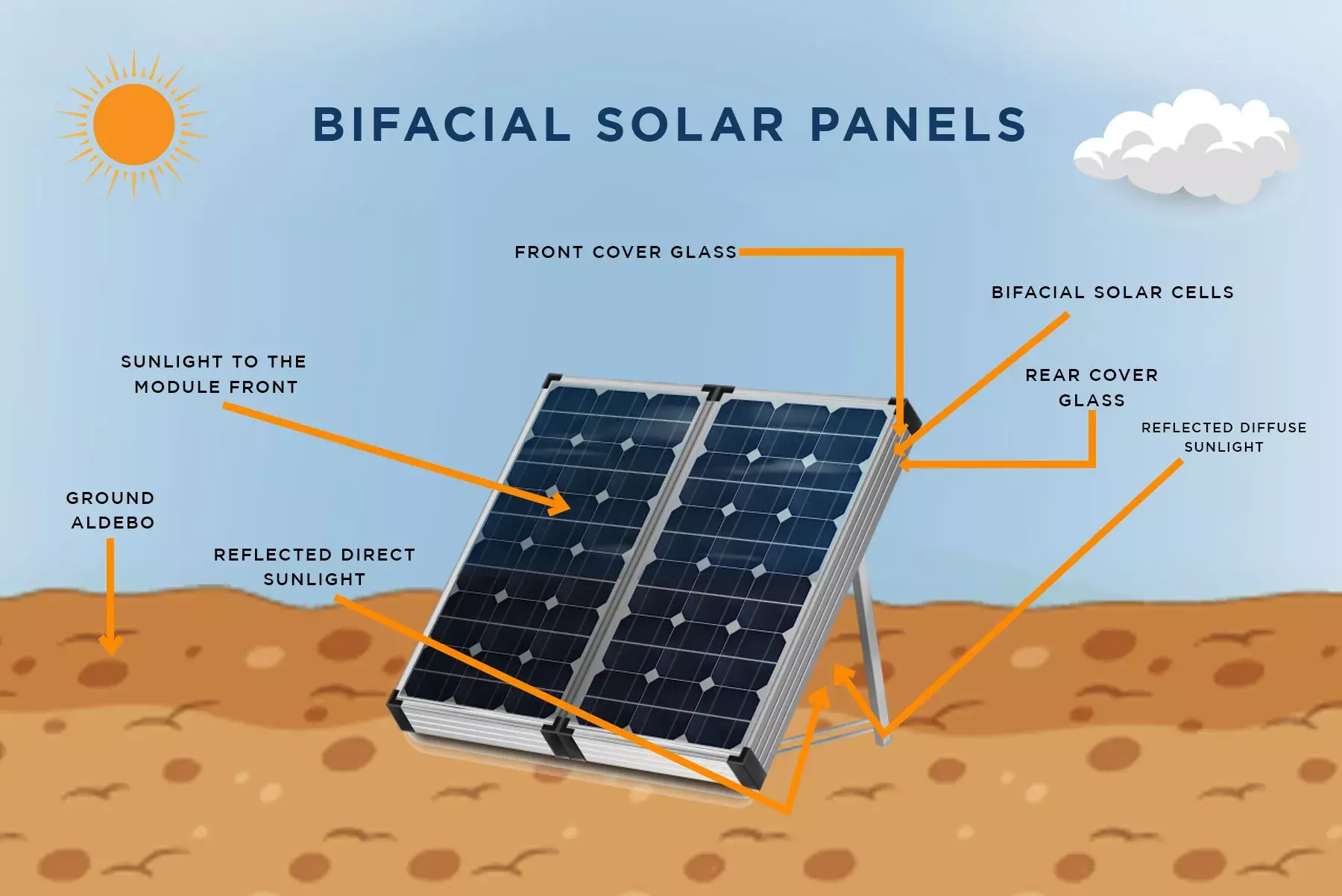
HISTORY AND THE DEVELOPMENT OF PHOTOVOLTAICS: https://ae-solar.com/history-of-solar-module/#:~:text=The%20first%20solar%20panel%20was,efficiency%20of%20only%20about%201%25. (AESOLAR TIER1 Company) (Accessed February 26, 2024)
• The first efficient photovoltaic cell was developed during the 1950’s.
• The absolute first solar cell was made 1839 by Edmond Becquerel
• The first solar panel was invented by Charles Fritts in 1883, which had an efficiency of 1%.
• 3 major types of solar panels are monocrystalline, polycrystalline, and thin-film panels.
Variables
Independent Variable: Angle of the panel (angled up or down)
Dependent Variable: Amount of energy generated
Controlled Variables: Amount of time outside, Starting battery percentage
Procedure
Materials
- Anker Solix C1000 Battery + Panel
- Phone with Lux Light Meter Pro
- Phone with Framelapse
- Thermometer
- Undisturbed snow
- A thin wooden plank to hold up the solar panel when angled down
- A large protractor to measure the angle
Set Up
- We tested UV Grow Lights but they weren’t strong enough, so we designed an outdoor experiment in my backyard with sunlight.
- I determined that a 55-degree angle had the highest light, using a large protractor and the Lux Light Meter Pro app.
- I used a wooden stick to ensure it was at the same angle facing up or down.
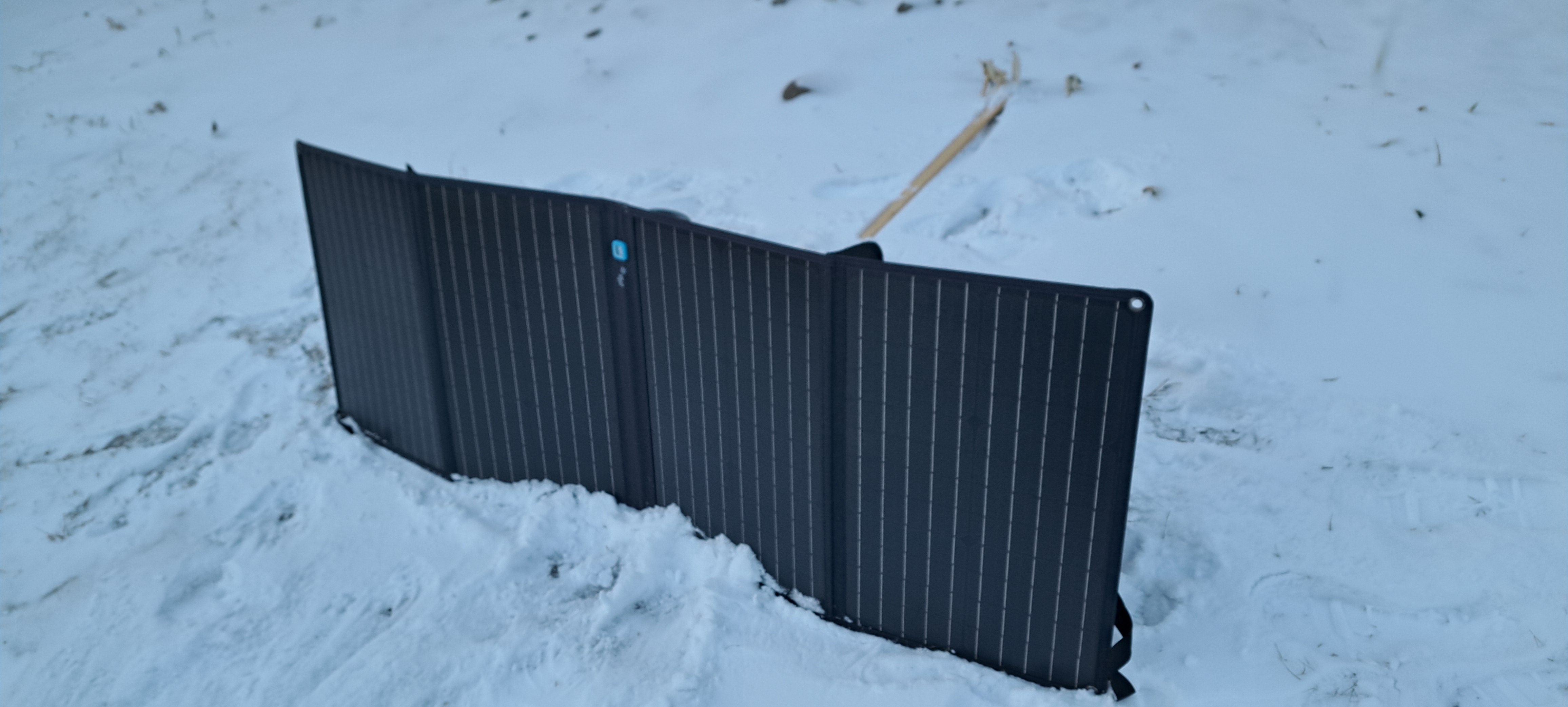
Photo 1: Face up set up
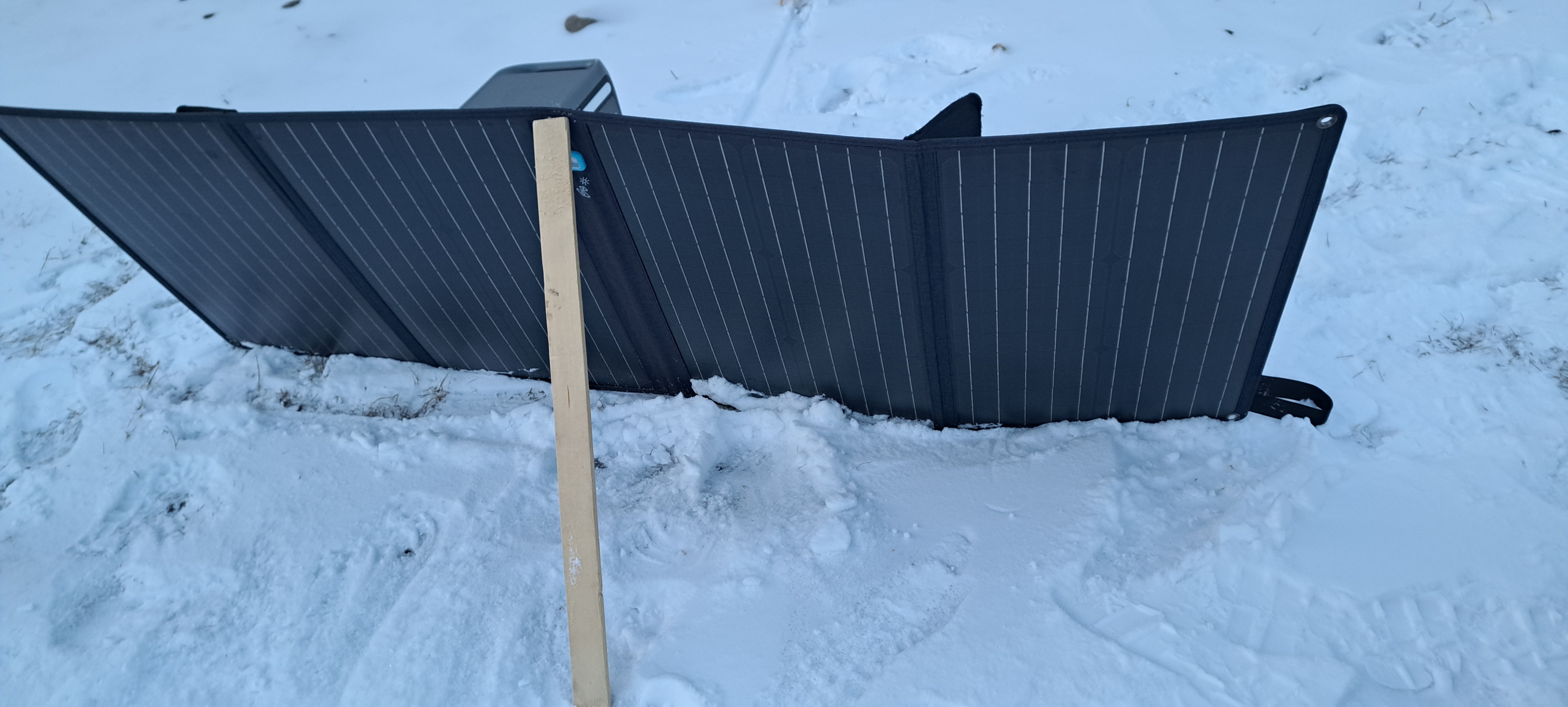
Photo 2: Face down set up
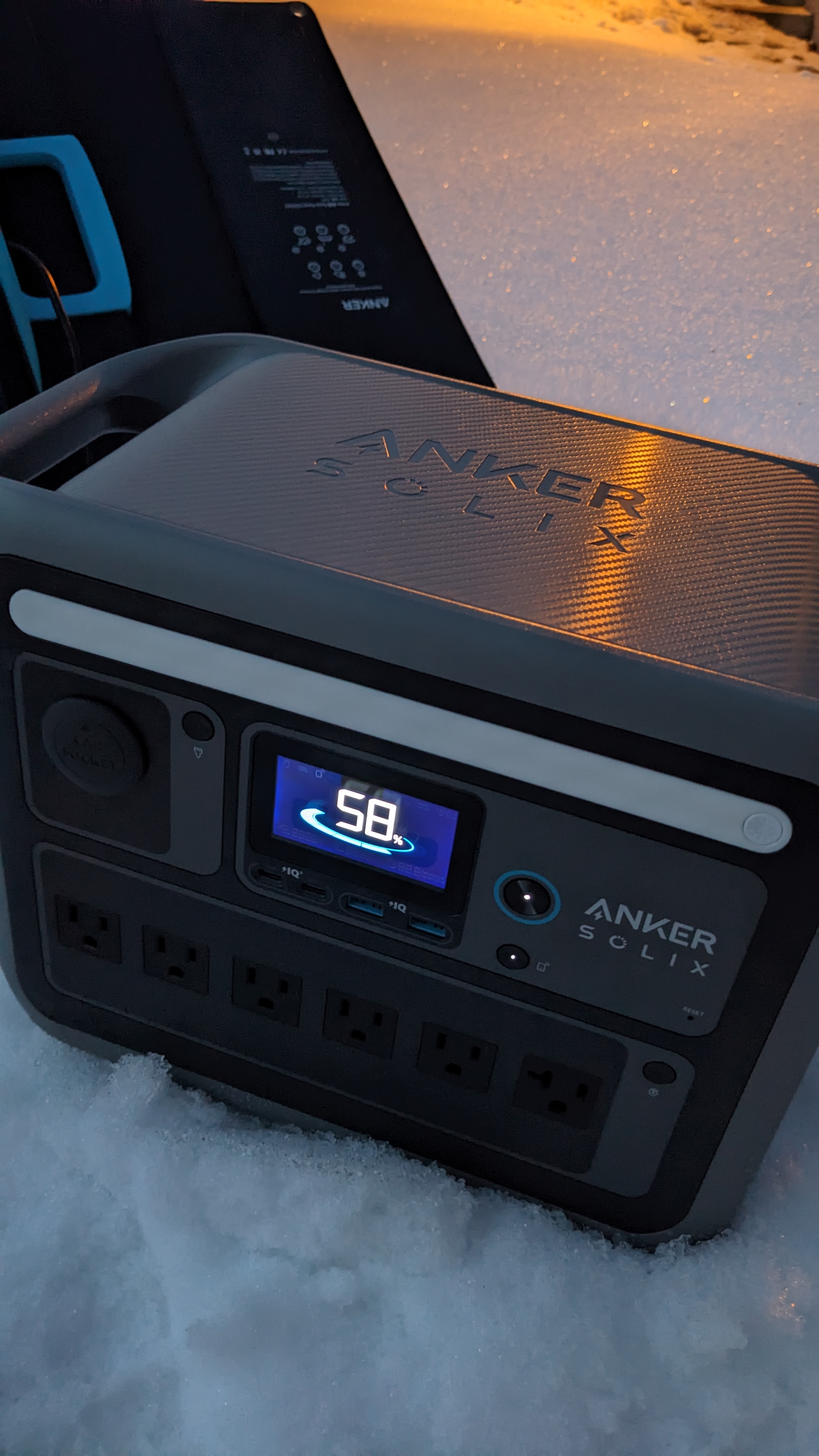
Photo 3: Solar battery

4: Original face down design
Measuring Cloud Cover and Light
- I used Framelapse (Free) to do the cloud cover measurement over the day.
- I used Lux Light Meter Pro to check the light level at solar noon. The phone was angled up or down depending on the angle of the solar panel.
Link example of timelapse: https://drive.google.com/file/d/1esf6S0ST-ILVSknX6ouCLYHFAw7hHViY/view
Procedure
- On the days I tested, at 7:40am, I set up my solar panel at a 55-degree angle (facing up or down).
- Then I set up a time lapse to measure cloud cover. I used Framelapse (Free) to do the cloud cover.
- I realized that the light wouldn't be the same, so I downloaded the Lux Light Meter Pro app, and it measures lux (lumens per square foot).
- At solar noon (included in the table) I (or my dad) measured the lux at the angle of the solar panel (facing up or down).
- At around 4:00pm, the solar panel was completely covered by shade, so I took it down then.
- I estimated the cloud cover with the timelapse. I started with 1-hour intervals between frames, but the videos were too short so I had to adjust it to 2-minute intervals.
- I wrote down the start and end time, temperature and battery %. I calculated the % change of battery charge.
Observations
- The solar panel angled up generated more electricity. I learned that there was a big difference between amount of electricity generated.
- On very cloudy days, it hardly charged facing down, but could charge 8% - 40% facing up in very cloudy or snowy conditions.
- On sunny days, facing down could still charge 21% from the snow reflection. On partly cloud days, it charged the battery a maximum of 45%.
- Due to windy conditions, I did not get the full results on sunny days facing up (solar panel fell over).
- On days where I couldn’t take some data, my table it shows N/A (not available).
| DATE | ANGLE | CLOUD COVER (RANGE) | SUNLIGHT (LUX) AT SOLAR NOON | CIVIL TWILIGHT (VISIBLE SUNLIGHT HOURS) | TIME | TEMPERATURE (⁰C) | BATTERY | ||||||||
| MIN. | MAX. | AVG. | START (AM) | END (PM) | SOLAR NOON (PM) | START (AM) | END (PM) | START | END | % START | % END |
% CHANGE | |||
| 28-Jan | Down | Heavy | N/A | N/A | N/A | 7:41 | 5:57 | 12:49 | 7:40 | 4:00 | -1 | 5 | 57% | 57% | 0% |
| 29-Jan | Down | Heavy | 1813 | 3258 | 2906 | 7:39 | 5:59 | 12:49 | 7:40 | 4:00 | 0 | 0 | 55% | 55% | 0% |
| 30-Jan | Down | Medium | 3523 | 12283 | 7028 | 7:38 | 6:01 | 12:49 | N/A | N/A | N/A | N/A | 55% | 57% | 2% |
| 31-Jan | Down | Medium | N/A | N/A | N/A | 7:37 | 6:02 | 12:49 | 7:40 | 4:00 | -1 | 2 | 57% | 63% | 6% |
| 6-Feb | Down | None | 61135 | 80111 | 69988 | 7:28 | 6:12 | 12:50 | 7:40 | 4:00 | 0 | 8 | 63% | 84% | 21% |
| 7-Feb | Down | Heavy | 4034 | 6726 | 6523 | 7:27 | 6:14 | 12:50 | 7:35 | 5:11 | -5 | -6 | 82% | 82% | 0% |
| 11-Feb | Down | Light | 18004 | 59986 | 39960 | 7:20 | 6:21 | 12:50 | 8:30 | 7:40 | 6 | 0 | 49% | 60% | 11% |
| 12-Feb | Down | Med-Light | 7220 | 24609 | 20728 | 7:18 | 6:22 | 12:50 | 7:50 | 5:30 | 6 | -4 | 60% | 72% | 12% |
| 13-Feb | Down | Med-Light | 11847 | 18420 | 12275 | 7:17 | 6:24 | 12:50 | 7:40 | 4:30 | -5 | 2 | 42% | 52% | 10% |
| 14-Feb | Down | Heavy-Med | 14649 | 17969 | 16073 | 7:15 | 6:26 | 12:50 | 7:40 | 4:30 | -10 | -2 | 52% | 56% | 4% |
| 15-Feb | Up | Heavy-Light | 9864 | 121942 | 92633 | 7:13 | 6:27 | 12:50 | 7:50 | 4:00 | -10 | -10 | 56% | 96% | 40% |
| 16-Feb | Up | Heavy-Med | 93528 | 124686 | 119267 | 7:11 | 6:29 | 12:50 | 7:40 | 4:40 | -1 | 5 | 35% | 59% | 24% |
| 17-Feb | Up | Med-None | 108366 | 131458 | 118506 | 7:10 | 6:31 | 12:50 | 7:40 | 4:00 | -1 | 2 | 59% | 85% | 26% |
| 18-Feb | Up | Light-None | 122324 | 127850 | 125020 | 7:08 | 6:33 | 12:50 | 7:40 | 5:00 | -4 | -1 | 55% | 100% | 45% |
| 20-Feb | Up | Light | 11070 | 127975 | 102237 | 7:04 | 6:36 | 12:49 | 7:30 | 4:00 | -3 | 1 | 75% | 100% | 25% |
| 23-Feb | Up | Light | 99770 | 127975 | 103533 | 6:58 | 6:41 | 12:49 | 7:40 | 4:10 | 1 | -1 | 69% | 100% | 31% |
| 24-Feb | Up | Snow-Heavy | N/A | N/A | N/A | 6:56 | 6:43 | 12:49 | 7:40 | 4:00 | -1 | -3 | 23% | 31% | 8% |
| 25-Feb | Up | Very Heavy | N/A | N/A | N/A | 6:54 | 6:44 | 12:49 | 7:30 | 4:40 | 3 | -2 | 16% | 33% | 17% |
| 26-Feb | Up | N/A | N/A | N/A | N/A | 6:52 | 6:46 | 12:49 | 7:30 | N/A | 3 | N/A | 33% | N/A | N/A |
| 27-Feb | Up | N/A | N/A | N/A | N/A | 6:50 | 6:48 | 12:49 | 7:30 | N/A | -11 | N/A | N/A | N/A | N/A |
| 8-Mar | Up | Very Heavy | 24495 | 122165 | 128625 | 6:25 | 7:05 | 12:46 | 7:30 | 4:00 | -13 | 5 | 66% | 75% | 9% |
See Additional Attachments for results table
Analysis
- Partway through, I realized that I needed to drain the battery so I started to do that (to about 50%) to have another controlled variable.
- Even facing down, the solar panel could still generate 21% on a sunny day. Having bifacial solar panels would increase electricity generation in the winter.
- Later in the experiment, the sun was getting stronger and lasting a little longer. In the summer, the solar panel would generate a lot more in less time.
- Next time I would drain the battery down more to see the if it would charge even more.
- I would change the position of the panel because at 4:00 pm the panel would fall into full shade.
- I would also try to do this experiment when there’s more snow so the face down design can generate more electricity. I could test different angles.
- I would also make something to secure the panel so it wouldn’t fall in the wind.
- Because I experimented outside, I couldn’t control a lot of variables such as the temperature, weather, cloud cover and amount of sunlight. I tracked these variables but needed more days to compare the face up and face down in similar sunnier conditions.
- My solar panel also produced less when it was lower than 0⁰C. I could see how much temperature affects the performance of the solar panel and battery.
Conclusion
- My hypothesis was incorrect because the solar panel angled-up generated a lot more watt hours.
- Solar panels, even in winter time, can generate enough electricity for some home appliances to run for days with one charge.
- Having bifacial solar panels would increase electricity generation in the winter.
- In the summer, the solar panel would generate a lot more in less time
- I could investigate the average energy generated by an industry grade bifacial solar panel.
- Next time, I could also try this in the summer and see if the albedo effect off of the grass could also generate electricity and see how much.
Application
With this data, solar companies could put more bifacial panels in this region to increase their electricity generation.
Sources Of Error
- Because I experimented outside, I couldn’t control a lot of variables such as the temperature, weather, cloud cover and amount of sunlight. These affected the amount of electricity generated. I also estimated cloud cover, it wasn't exact. When it was windy, it fell down a lot so the results were inaccurate.
- At 4:00 pm the panel would fall into full shade so I couldn't charge for the whole day.
Citations
Photovoltaic system: https://energyeducation.ca/encyclopedia/Photovoltaic_system (Dr. Jason Donev, University of Calgary) (Accessed February 26, 2024)
Successful projects: https://www.csisolar.com/successful-projects/ (Canadian Solar) (Accessed February 26, 2024)
How Do Solar Panels Work?: https://science.howstuffworks.com/environmental/energy/solar-cell.htm (Scott Aldous & Talon Homer, HowStuffWorks.com) (Updated: Aug 30, 2023, Accessed February 26, 2024)
How Does Solar Work?: https://www.energy.gov/eere/solar/how-does-solar-work#:~:text=When%20the%20sun%20shines%20onto,cell%2C%20causing%20electricity%20to%20flow. (Office of Energy Efficiency & Renewable Energy, U.S. Department of Energy) (Accessed February 26, 2024)
Solar Photovoltaic Technology Basics: https://www.nrel.gov/research/re-photovoltaics.html
(National Renewable Energy Laboratory, U.S. Department of Energy) (Accessed February 26, 2024)
Solar explained: Photovoltaics and electricity: https://www.eia.gov/energyexplained/solar/photovoltaics-and-electricity.php#:~:text=A%20photovoltaic%20(PV)%20cell%2C,or%20particles%20of%20solar%20energy (U.S. Energy Information Administration) (Accessed February 26, 2024)
How Bifacial Solar Panels Work and Why They Are So Efficient: https://www.novergysolar.com/bifacial-solar-panels/ (Novergy Energy Solutions Pvt. Ltd.) (Accessed February 26, 2024)
Sunrise, Sunset for Calgary, Alberta, Canada: https://geotimedate.org/sun/canada/alberta/calgary (GeoTimeDate) (Accessed February 6, 2024)
Definitions of Twilight: https://www.weather.gov/fsd/twilight#:~:text=Civil%20Twilight%3A&text=Therefore%20morning%20civil%20twilight%20begins,6%20degrees%20below%20the%20horizon. (National Weather Service, National Oceanic and Atmospheric Administration, U.S.A) (Accessed February 26, 2024)
Daily (Weather) Data Report for February 2024, CALGARY SPRINGBANK (AB):
https://climate.weather.gc.ca/climate_data/daily_data_e.html?hlyRange=2014-04-03%7C2024-02-26&dlyRange=2018-10-29%7C2024-02-26&mlyRange=%7C&StationID=52200&Prov=AB&urlExtension=_e.html&searchType=stnProx&optLimit=specDate&Month=2&Day=1&StartYear=1840&EndYear=2021&Year=2024&selRowPerPage=25&Line=0&txtRadius=25&optProxType=navLink&txtLatDecDeg=51.076116666667&txtLongDecDeg=-114.22224722222&timeframe=2
(Government of Canada) (Accessed February 26, 2024)
Average Calculator: https://www.calculator.net/average-calculator.html (Calculator.Net, Maple Tech. International LLC) (Accessed February 26, 2024)
HISTORY AND THE DEVELOPMENT OF PHOTOVOLTAICS: https://ae-solar.com/history-of-solar-module/#:~:text=The%20first%20solar%20panel%20was,efficiency%20of%20only%20about%201%25. (AESOLAR TIER1 Company) (Accessed February 26, 2024)
Acknowledgement
I had lots of support from my parents, and also a lot from my uncle who loaned me the solar panel and battery. A big thank you to Mme. Jacques and Mme. Roe for the support over the year. Thanks to all my science club friends that helped me along the way.

